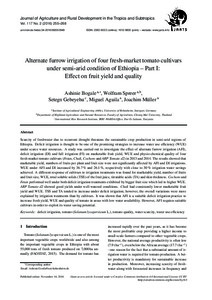Aufsatz

Alternate furrow irrigation of four fresh-market tomato cultivars under semi-arid condition of Ethiopia – Part I: Effect on fruit yield and quality
Zusammenfassung
Scarcity of freshwater due to recurrent drought threatens the sustainable crop production in semi-arid regions of Ethiopia. Deficit irrigation is thought to be one of the promising strategies to increase water use efficiency (WUE) under scarce water resources. A study was carried out to investigate the effect of alternate furrow irrigation (AFI), deficit irrigation (DI) and full irrigation (FI) on marketable fruit yield, WUE and physio-chemical quality of four fresh-market tomato cultivars (Fetan, Chali, Cochoro and ARP Tomato d2) in 2013 and 2014. The results showed that marketable yield, numbers of fruits per plant and fruit size were not significantly affected by AFI and DI irrigations. WUE under AFI and DI increased by 36.7% and 26.1%, respectively with close to 30% irrigation water savings achieved. A different response of cultivars to irrigation treatments was found for marketable yield, number of fruits and fruit size, WUE, total soluble solids (TSS) of the fruit juice, titratable acids (TA) and skin thickness. Cochoro and Fetan performed well under both deficit irrigation treatments exhibited by bigger fruit size which led to higher WUE. ARP Tomato d2 showed good yields under well-watered conditions. Chali had consistently lower marketable fruit yield and WUE. TSS and TA tended to increase under deficit irrigation; however, the overall variations were more explained by irrigation treatments than by cultivars. It was shown that AFI is a suitable deficit irrigation practice to increase fresh yield, WUE and quality of tomato in areas with low water availability. However, AFI requires suitable cultivars in order to exploit its water saving potential.
Zitierform
In: Journal of Agriculture and Rural Development in the Tropics and Subtropics. Kassel : Kassel University Press. - Vol. 117, No. 2 (2016), S. 255-268Sammlung(en)
Vol 117, No 2 (2016) (Journal of Agriculture and Rural Development in the Tropics and Subtropics (JARTS))Zitieren
@article{urn:nbn:de:hebis:34-2016092050949,
author={Bogale, Ashinie and Spreer, Wolfram and Gebeyehu, Setegn and Aguila, Miguel and Müller, Joachim},
title={Alternate furrow irrigation of four fresh-market tomato cultivars under semi-arid condition of Ethiopia – Part I: Effect on fruit yield and quality},
year={2016}
}
0500 Oax 0501 Text $btxt$2rdacontent 0502 Computermedien $bc$2rdacarrier 1100 2016$n2016 1500 1/eng 2050 ##0##urn:nbn:de:hebis:34-2016092050949 3000 Bogale, Ashinie 3010 Spreer, Wolfram 3010 Gebeyehu, Setegn 3010 Aguila, Miguel 3010 Müller, Joachim 4000 Alternate furrow irrigation of four fresh-market tomato cultivars under semi-arid condition of Ethiopia – Part I: Effect on fruit yield and quality / Bogale, Ashinie 4030 4060 Online-Ressource 4085 ##0##=u http://nbn-resolving.de/urn:nbn:de:hebis:34-2016092050949=x R 4204 \$dAufsatz 4170 7136 ##0##urn:nbn:de:hebis:34-2016092050949
<resource xsi:schemaLocation="http://datacite.org/schema/kernel-2.2 http://schema.datacite.org/meta/kernel-2.2/metadata.xsd"> 2016-11-14T14:56:31Z 2016-11-14T14:56:31Z 2016-11-14 1612-9830 2363-6033 urn:nbn:de:hebis:34-2016092050949 http://hdl.handle.net/123456789/2016092050949 eng Kassel University Press Urheberrechtlich geschützt https://rightsstatements.org/page/InC/1.0/ deficit irrigation tomato (Solanum lycopersicum L.) tomato quality water scarcity water use efficiency 630 Alternate furrow irrigation of four fresh-market tomato cultivars under semi-arid condition of Ethiopia – Part I: Effect on fruit yield and quality Aufsatz Scarcity of freshwater due to recurrent drought threatens the sustainable crop production in semi-arid regions of Ethiopia. Deficit irrigation is thought to be one of the promising strategies to increase water use efficiency (WUE) under scarce water resources. A study was carried out to investigate the effect of alternate furrow irrigation (AFI), deficit irrigation (DI) and full irrigation (FI) on marketable fruit yield, WUE and physio-chemical quality of four fresh-market tomato cultivars (Fetan, Chali, Cochoro and ARP Tomato d2) in 2013 and 2014. The results showed that marketable yield, numbers of fruits per plant and fruit size were not significantly affected by AFI and DI irrigations. WUE under AFI and DI increased by 36.7% and 26.1%, respectively with close to 30% irrigation water savings achieved. A different response of cultivars to irrigation treatments was found for marketable yield, number of fruits and fruit size, WUE, total soluble solids (TSS) of the fruit juice, titratable acids (TA) and skin thickness. Cochoro and Fetan performed well under both deficit irrigation treatments exhibited by bigger fruit size which led to higher WUE. ARP Tomato d2 showed good yields under well-watered conditions. Chali had consistently lower marketable fruit yield and WUE. TSS and TA tended to increase under deficit irrigation; however, the overall variations were more explained by irrigation treatments than by cultivars. It was shown that AFI is a suitable deficit irrigation practice to increase fresh yield, WUE and quality of tomato in areas with low water availability. However, AFI requires suitable cultivars in order to exploit its water saving potential. open access In: Journal of Agriculture and Rural Development in the Tropics and Subtropics. Kassel : Kassel University Press. - Vol. 117, No. 2 (2016), S. 255-268 Bogale, Ashinie Spreer, Wolfram Gebeyehu, Setegn Aguila, Miguel Müller, Joachim Gedruckte Ausg. im Verlag Kassel Univ. Press (www.upress.uni-kassel.de) erschienen. </resource>
Die folgenden Lizenzbestimmungen sind mit dieser Ressource verbunden:
Urheberrechtlich geschützt

